Introduction
The Pew Internet Project has looked at how people use the internet in four major ways: to communicate, to gather information, to transact personal and professional business, and to entertain themselves.
1. Communications
Men and women communicate online differently.
In principle, internet users have high regard for the internet as a tool of communication; 85% of both men and women say they consider the internet to be a good way to interact or communicate with others in their everyday lives.14 But similarities end there. Men and women differ in their modes of online communication, in what they communicate about, and in how much they value their online communications.
Women are more voracious online communicators.
Over the last 5 years, we have polled users about different forms of online communications, both through our regular tracking polls and through one-time modules on communications within topics as varied as health care, civic and community life, and email in the workplace.
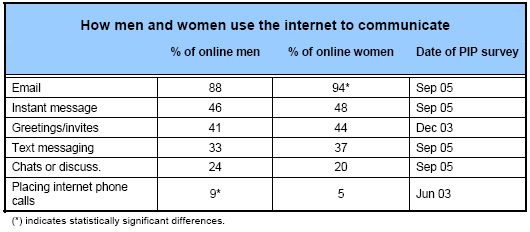
Women have always been slightly more likely than men to use email and to send cards, greetings and invitations and are pulling ahead of men in instant messaging and text messaging on cell phones. Men are more likely to have communicated online in chats or discussion groups and by making voice calls by voice over internet protocol, or VOIP.
Email is for everyone.
Email has always been the most popular application on the internet. Over 90% of internet users send and receive email. Since we began tracking email use in 2000, the number of men and women who do email has been about equal, with women sometimes taking a slight lead. Further, on an average day, just about the same number of men and women will access their email. As for volume on a typical day, men and women also say they receive about the same number of emails in both their work and personal accounts. But what goes into those emails and how the application is valued differs for men and women.
Women do more with personal email.
In March 2001, we asked users about email habits with their most frequent email correspondents. Women proved to email about a wider variety of topics with both friends and family. They were more likely to correspond with the favored family member about getting together; to pass along some interesting non personal or personal news; to discuss worries as well as information about jobs or other activities; and to forward jokes or humorous stories.
From time to time we have asked about emailing with family for other reasons. In November 2002, significantly more women than men said they emailed with family about health or medical issues. In March 2003, significantly more women than men said they emailed with family about the likelihood of upcoming war in Iraq. Immediately after the events of September 11, 2001, more women than men said they emailed with family about news of terror attacks and their aftermath.
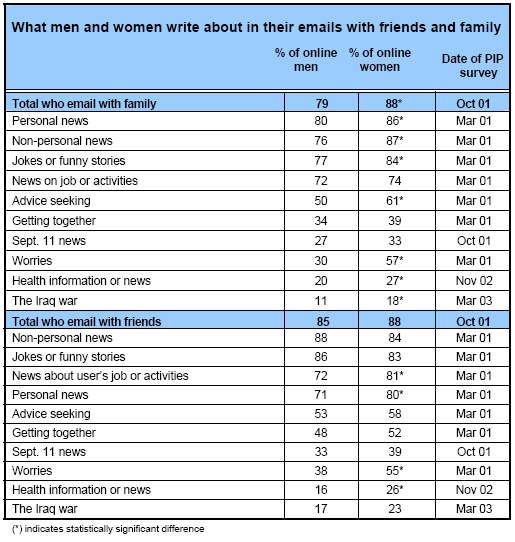
With the favorite friend, the picture was much the same: Women emailed more than men about getting together, to discuss worries, to pass along personal news and information about jobs or other activities. In two cases, men were more likely to email about topics with a favored friend: to pass along some interesting non personal news, and to forward jokes or humorous stories.
From time to time, we also asked users about emailing on various topics with friends. In November 2002, significantly more women than men said they emailed with friends about health or medical issues. In March 2003, more women than men said they emailed with friends about the possibility of upcoming war in Iraq. Immediately after the events of September 11, 2001, more women than men said they emailed with friends about the terror attacks.
Women find emailing with friends and family both more useful and more valuable than men do.
- Where email is useful
In November 2001, significantly more women than men said emailing with family is very useful to them. Slightly more women than men said this is true for friends, as well.
Of the most important reasons they choose to email with family, both men and women say convenience, 30% for men and 27% for women, and speed, 29% for men and 30% for women. More women, 19%, than men, 12%, appreciate that email is inexpensive. And 12% of both men and women find it useful for attaching pictures or documents to the emails.
Both men and women say the most important reason they choose to email with friends is also for convenience, 39% each for men and women. That is followed by speed, 31% for men, compared with 30% for women, and that it’s less expensive, 14% for women and 8% for men, and that they can attach pictures or documents, 11% for men and 9% for women.
- Where email is valuable
We asked about some of the softer measures of the value of email. In March 2001, more women, 43%, than men, 33%, said that communicating by email has improved relationships with their family members. More women than men said email has brought them closer to their family, and that they have learned more about their family by using email.
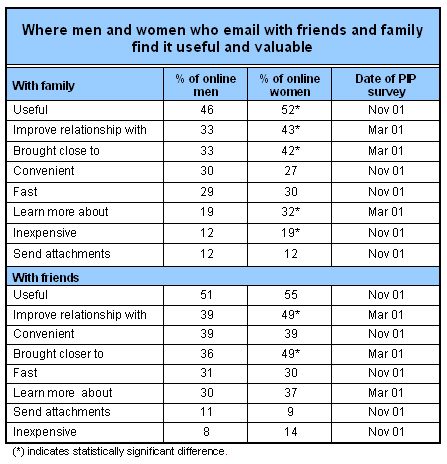
With respect to their friends, some 49% of women say this improved relationships with friends compared with 39% of men. More women than men say email has brought them closer to their friends and that they have learned more about friends by using email.
In November 2001, significantly more women, 52%, than men 45% , said they would miss using email a lot if they could no longer use it.
Women find emailing at work more effective and valuable than men do.
In May 2002, we asked users a battery of questions to compare email with phone or face-to-face contact for handling various tasks at work. More women than men named email as the most effective way to handle every work situation we queried: to make appointments; to edit or review documents; to ask questions about work issues; and to deal with problems with supervisors. Women were also consistently more likely than men to see email as a positive force in the workplace. More women than men said email improves teamwork in the workplace; expands their circle of colleagues at work; makes them more available to co-workers; helps them stay current with events at work; provides moments of relief from work; saves them time; and liberates them from being tied to the office.
Women were less likely than men to cite email’s negative effects. Women were less likely to say email makes it too easy for outsiders to reach them and makes them too accessible to others inside the company. Men and women were equally likely to consider email at work to be a source of stress, gossip, misunderstanding, and to say they can’t get away from it. Overall, more women, 20%, than men, 15%, give email in the workplace the highest praise, saying they “can’t live without it.”
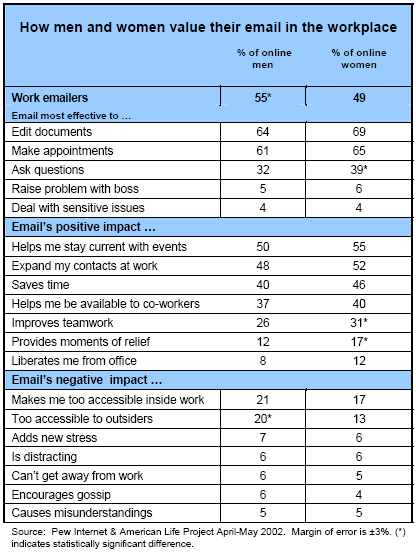
Men use the internet more than women to communicate and discuss issues with special interest groups.
In February 2001, we found that 84% of internet users belonged to some kind of online group or organization and that many of them had joined those groups after they had gotten internet access. In that survey there were some differences between men and women and the kinds of groups to which they belonged. More men said they went to the internet to communicate with or get information from a variety of special interest groups: trade and professional groups; hobby or interest groups; fan groups for a sport or sports team; groups for a sport team they participate in; lifestyle groups; groups for those who share personal beliefs; and political groups. For a number of other groups, men and women responded equally: entertainment fan groups; local or community groups; religious, cultural or ethnic groups; and labor unions. More women said they went to support groups for medical or personal situations.
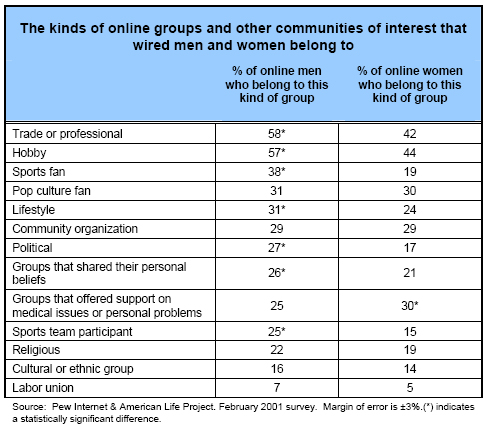
When asked about the special interest group they contact most often, nearly equal numbers of men, 63%, and women, 57%, say they use email. Also, significantly more men, 65%, than women, 53%, said they read or post messages on a special group’s listserv or bulletin board.
Using email with special interest groups is important to both men and women for getting hard news and information. Significantly more men than women think that discussing issues is an important reason to email with these special interest groups. More women than men say that maintaining or building personal relationships among group members is important to them.
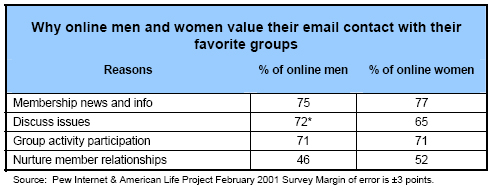
2. Transactions
Men do more a few more online transactions than women, including some with less predictable or controlled outcomes.
In their day-to-day lives, 75% of internet users believe that the internet offers them a good way to conduct their everyday business like banking or buying tickets, although men, at 78%, say this in significantly higher numbers than women, at 71%.15
Over the last five years, the Pew Internet Project has been tracking users’ participation in more than a dozen kinds of online transactions. Men and women are about equally likely to go online to do many of these: to buy products, as well as everyday items like groceries, food, and household items and prescriptions; to make travel arrangements or to purchase tickets; to do their banking; and to donate to charities.
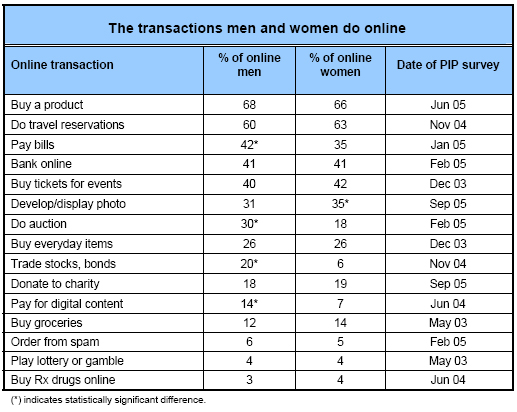
Men are significantly more likely to pay bills online and to pay for online content. They are also more likely to do more of the online transactions with less predictable outcomes: bidding in auctions and trading stocks, bonds or mutual funds. A very small and equal number of both men and women also order from unsolicited email and gamble online.
Men and women share an increasing enthusiasm for doing transactions on the internet.
The ability to do different kinds of transactions online has been one of the biggest attractions of the internet over the last few years. Participation rates among some of the transactional activities the Pew Internet Project has tracked regularly have eclipsed those for other online functions, including communications, getting information, and enjoying entertainment.
Participation in online banking grew from 17% in 2000 to 41% in 2005; in doing travel arrangements online grew from about a third in 2000 to nearly two-thirds in 2004; in buying products like books, music, toys, and clothing from 48% in 2000 to 67% in 2004; in online auctions from 15% overall in 2000 to 24% in 2005, including men’s rate from 19% to 30%, and women’s from 11% to 18%.
Some online transaction activities have not taken off as dramatically. In March 2000, 16% of men and 9% of women bought or sold stocks. By November 2004, men’s participation rose to 20%, while women’s fell to 6%.
Men and women like online transactions for mostly the same reasons, with convenience and speed leading.
The Pew Internet Project has polled internet users about the reasons they value three online transactions, banking, shopping, and buying prescriptions.
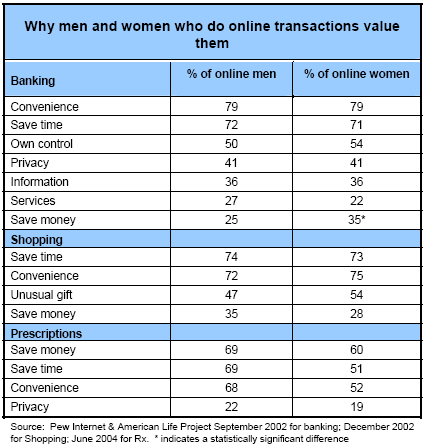
Men and women share most reasons they value online banking. About three-quarters of both men and women said they appreciated both the convenience and time savings. Many also said they appreciate the privacy of online banking and the accessibility to so much information and so many services online. Men and women differed significantly in only one element: More women than men said they valued online banking for the savings in cost.
For online shopping, both men and women cite convenience and time savings as major reasons to like shopping online. Further, more men than women value cost savings, and more women than men appreciate the chance to find unusual gifts.
And finally in June 2004, both men and women cited convenience and savings of time and money as very important reasons to have bought prescription drugs online, although the overall number of internet users who have bought drugs online remains very low, about 4%.
3. Getting information
All internet users have a high regard for the internet as a source of information, but men look for a broader range of information online than women do.
Nearly all internet users, 91%, agree that the internet is a good source of information for everyday interests like news, weather reports, and sports scores.16 About 80% of both men and women also expect to find information online about more specialized topics of government issues and health or medical issues. The same number also say they expect to find information on particular products they want to purchase, although this includes more men, 82%, than women, 77%. About a third of internet users say they expect to find reliable information online about individuals.17
Beginning in 2000, we asked users about the kinds of information they look for online. Men and women are equally likely to get travel information and to look up phone numbers and addresses. They also look for information about the government, about colleges, jobs, and places to live.
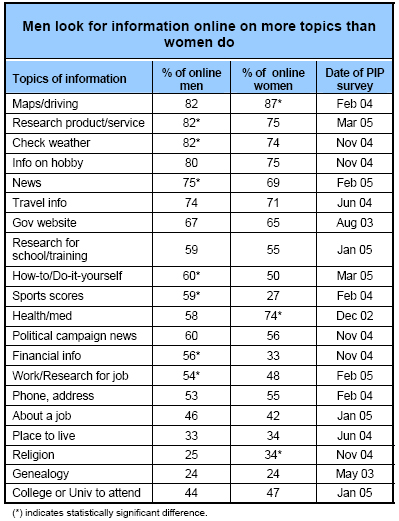
Significantly more men than women go online to get news and financial information, to check the weather and look up sports scores. Men also do research about products and services as well as research for their jobs. They look up more how-to information.
More women look for health and medical information, for maps and driving instructions and for information on religion.
In emergencies, more men use the internet to focus on information and more women to focus on people.
The Pew Internet Project looked in depth at a few extraordinary instances where users might go to the internet for information. In the fall of 2001, we asked users about the kinds of websites they had visited after the events of September 11. Significantly more men had visited a larger variety of different kinds of websites that would be sources of information, including news media sites, business sites, government or military sites, international sites, political sites, discussion groups, and portals. Men and women were equally as likely to visit personal websites, sites for charities, religious groups, and interest or advocacy groups.
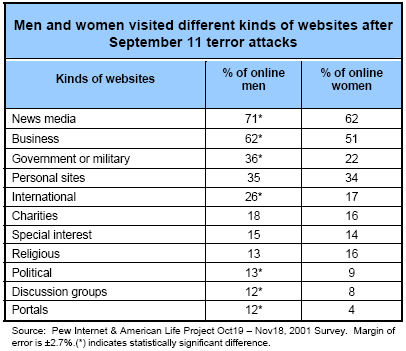
In the same survey, we asked users how the internet helped through the events of September 11. More men, 30%, than women, 25%, said the internet helped them a lot to learn more about what was going on, while more women, 56%, than men, 50%, said it helped them connect with people they needed to reach. These differences are statistically significant.
Men and women share similar search habits to get information.
In September 2005, about 90% of both men and women were using search engines to find information. Women’s history with search engine use is more volatile than men’s. In June 2003, 88% of women used search engines; it dipped to 79% in June 2004, and rose back to 91% in September 2005. Men’s use has held steady at about 90%.
The rise in search engine use on an average day, from about 35% for men and 25% for women in June 2003 and June 2004, soared for both in September 2005, to 43% for men and 39% for women. This coincides with the recent popular excitement about major search engines, including the vastly expanding volume searchable content, the IPOs, and the widely reported competition among them.
Search engines are just one way to find information online. As alternatives, searchers return to familiar websites or follow recommended links. The Pew Internet Project looked more closely at searchers’ strategies for three specific kinds of informational searches: for health and medical issues, government issues, and religious issues.
Men and women use similar strategies in launching their searches. Most users who are looking for information about health or government issues will start with search engines or portals. For instance, when asked about their most recent searches for health information, 85% of men and 78% of women said they went first to search engines or to general portals that included search engines.18 Similarly, when asked about the last time they searched for government information or services, 48% of men and 51% of women started at engines or portals.19 Then, as a secondary strategy, 29% of men and 28% of women went to sites they had already used. In looking for religious information, both men, 44%, and women, 49%, were most likely to start their searches at familiar religious websites.20 Both turned to search engines or general portals as a second resort; 37% of men and 35% of women.
Women handle less information online but feel the information glut more.
Although men gather and consume more information online, women seem more overwhelmed by the volume of information around them. In October 2002, we asked users about their sense of information overload in the context of growing volumes of easily-attainable information from TV, newspapers, online information services, magazines, etc. Although most users, including 65% of women and 70% of men, said they like having lots of information, significantly more women, 24%, than men, 19%, felt overloaded by it.
4. Entertainment
Men participate in more kinds of online entertainment than women.
Just over two thirds of users think the internet is a good place to pursue entertainment or personal enjoyment, including significantly more men, 72%, than women, 66%.21
Over the years, the Pew Internet Project has asked internet users about a grab bag of activities they do online for fun, recreation, and entertainment. Men and women participate equally in about half the activities we polled, but men are more likely than women to participate in the rest of the activities.
In the light entertainment category, about two-thirds of men and women surf the web for fun. With hobbies, slightly more men than women go online looking for information about their hobbies and many more actually pursuing their special interests online. Men also participate more seriously than women in sports fantasy leagues. A small but equal number of men and women said they have gone online to play the lottery or gamble.

We have occasionally asked users about visiting adult websites. The overall participation rates have remained constant, from about 13% – 15%. Traditionally, three to five times as many men as women have responded positively to this question.
Men have recently closed the gap with women in playing online games. Women have traditionally led men in this data point; as late as November 2004, significantly more women, 44%, than men, 34%, said they had played games online. In that same survey, about equal numbers of men and women also said they downloaded such games to play online.22
Among more serious endeavors, significantly more men than women said they read for pleasure online and have taken a class online for personal enjoyment or enrichment.
Men do more online watching and listening
We have asked about online audio and video activities in a variety of ways. Overall, men are more enthusiastic than women about using the internet as kind an entertainment center for watching and listening.
Just over half of both online men and women have watched video clips or listened to audio clips online, a number that has risen slowly but steadily over the last 5 years, with women closing an earlier gap.
About a third of internet users, including significantly more men than women, have listened to music online at websites of places like a radio station, music store, recording artist or music service. Similar numbers have listened to live or recorded broadcasts of shows like newscasts, sporting events, or a radio show.
We also asked about downloaded entertainment. About a quarter of users have downloaded music files for later, anytime use, including significantly more men than women. This number had been growing to nearly a third of internet users at the end of 2002 and the first half of 2003, when suits against illegal file sharing brought by the Recording Industry Association of America encouraged many internet users to stop downloading music. In June 2003, the total number was 30%. By November 2003, the participation rate fell to 14%. The number has risen since then to the current 25% in May 2005. Men have always led women in downloading.
Significantly more men than women have downloaded other kinds of files as well, including video files, games, and picture files.
An equal number of men and women, about a quarter of all internet users, have shared various kinds of files as well.
In a first-time question in January 2005, we also asked users if they ever take online material, like songs, text, or images to remix. Significantly more men than women have done this.


